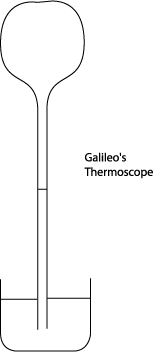He first heated the bulb
with his hands then immediately put it into water. He recorded that the water
rose in the bulb the height of “one palm”. Later, either Galileo or his
colleague Santorio Santorio put a paper scale next to the tube to read off
changes in the water level. This definitely made it a thermometer, but who
thought of it first isn’t  clear (they argued about it). And, in fact, this
thermometer had problems.
clear (they argued about it). And, in fact, this
thermometer had problems.
Question : what problems? If you occasionally top up the water, why shouldn’t this thermometer be good for recording daily changes in temperature?
Answer : because it’s also a barometer! But—Galileo didn’t know about the atmospheric pressure.
Torricelli, one of Galileo’s pupils, was the first to realize, shortly after Galileo died, that the real driving force in suction was external atmospheric pressure, a satisfying mechanical explanation in contrast to the philosophical “nature abhors a vacuum”. In the 1640’s, Pascal pointed out that the variability of atmospheric pressure rendered the air thermometer untrustworthy.
Liquid-in-glass thermometers were used from the 1630’s, and they were of course insensitive to barometric pressure. Meteorological records were kept from this time, but there was no real uniformity of temperature measurement until Fahrenheit, almost a hundred years later.
Unknown title
perature change, a thermometer can measure the temperature change.) Galileo used an inverted narrow-necked bulb with a tubular neck, like a hen’s egg with a long glass tube attached at the tip. <span>He first heated the bulb with his hands then immediately put it into water. He recorded that the water rose in the bulb the height of “one palm”. Later, either Galileo or his colleague Santorio Santorio put a paper scale next to the tube to read off changes in the water level. This definitely made it a thermometer, but who thought of it first isn’t clear (they argued about it). And, in fact, this thermometer had problems. Question: what problems? If you occasionally top up the water, why shouldn’t this thermometer be good for recording daily changes in temperature? Answer: because it’s also a barometer! But—Galileo didn’t know about the atmospheric pressure. Torricelli, one of Galileo’s pupils, was the first to realize, shortly after Galileo died, that the real driving force in suction was external atmospheric pressure, a satisfying mechanical explanation in contrast to the philosophical “nature abhors a vacuum”. In the 1640’s, Pascal pointed out that the variability of atmospheric pressure rendered the air thermometer untrustworthy. Liquid-in-glass thermometers were used from the 1630’s, and they were of course insensitive to barometric pressure. Meteorological records were kept from this time, but there was no real uniformity of temperature measurement until Fahrenheit, almost a hundred years later. Newton’s Anonymous Table of Temperatures The first systematic account of a range of different temperatures, “Degrees of Heat”, was written by Newton, but published anonymously, in 1701.
Summary
| status | not read | reprioritisations | ||
|---|---|---|---|---|
| last reprioritisation on | suggested re-reading day | |||
| started reading on | finished reading on |